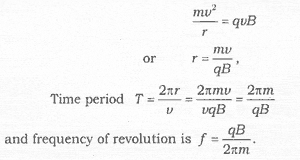(Important Topics) Physics: Cyclotron Explained with Equations
Disclaimer: This website is NOT associated with CBSE, for official website of CBSE visit - www.cbse.gov.in

Important Topics Physics: Cyclotron Explained with Equations
It is a device developed by Lawrence and Livingstone and is used to
accelerate charged particles like protons and deuterons. This results in the
production of high energy beam which is then used for artificial disintegration,
etc.
It consists of two D shaped metal boxes (about 21″ in diameter) with their
straight sides facing each other. There is a very small gap between these Dee’s
faces across which a high potential difference (of order of 105 volts) is
applied by a high frequency (10-15 mega cycles per second) oscillator. Thus an
alternating electric field is established between Dee’s during one half cycle,
one dee is positive and the other is negative while during the next half cycle,
the other is positive and one is negative. A source of particle (heavy hydrogen
for producing deutrons) is placed between the faces. The whole apparatus is
placed between the pole pieces NS of a very strong magnet.


Suppose a deuteron is at the centre of the gap and D1 is at
negative potential compared to D2 then deuterons will be accelerated by the
electric field between the dees towards D1. Since magnetic field B is
perpendicular to the direction of motion of deuteron, a force will act on the
particle given by
F = qv x B (where v and B are vectors) = qvB
Consequently, particle moves along a circular path whose radius is given by

So time period and frequency is independent of speed of charge and radius of circular path. If this frequency is equal to the frequency of the oscillator then by the time particle complete half revolution the polarity of the field will change. Deuteron will again be accelerated across the gap, its velocity will increase so that now it will move in a circular path of greater radius but its frequency will not be affected and the process of acceleration continues.
The particle is thus accelerated to gain high velocity. Its kinetic energy increases and when radius of the path reaches upto the value of the radius of the dee (R), beam is deflected by a negatively charged plate. Therefore with r=R, its maximum kinetic energy will be

So the necessary condition for accelerating the deuterons is-
f=fo

where f0 is oscillator frequency. This is called resonance condition.
As velocity attained is high, we choose heavier particles e.g., protons, deuterons for acceleration in cyclotron. The reason is that at such high velocities, mass varies with velocity and f will then depend on velocity, upsetting the resonance condition. This variation in mass is more marked in the case of lighter particles. So cyclotron is suitable only for accelerating heavy particle like protons, deuterons a - particles etc.
Electrons can not be accelerated by cyclotrons because the mass of electron
is very small and a small increase in energy of electron makes
the electrons move with very high speed. As a result of it the electron go
quickly out of step with oscillating electric field, it is for these reasons
that other accelerating machines such as synchrotron, betatron (for accelerating
electrons) have been developed. Cyclotron can not be used for accelerating
uncharged particle like neutrons.
Cyclotron in India: Variable Energy Cyclotron Centre (VECC) is located in Calcutta, India.The Centre building itself houses a 224 cm cyclotron, was the first of its kind in India, having been operational since 1977-06-16. It provides proton, deuteron, alpha particle and heavy ion beams of various energies to other institutions.